Study on the Agricultural Financial Development of South Korea
,
1. Global Business Department, Konkuk University, Seoul 05029, South Korea; 2. Co-Innovation Center for Korean Peninsula Studies / College of Economics and Management, Yanbian University, Yanji 133000, China
1 Introduction
Agricultural finance in South Korea refers to the public expenditure of the state for supporting agriculture. In a broad sense, it refers to the comprehensive budget of the state. In a narrow sense, it refers to the investment and financing of the government. Agriculture is weaker than other industries[1]. Therefore, it is inseparable from support of many agricultural financial policies no matter in raising the production efficiency or increasing income of farmers[2]. In the development of agriculture and fishery, simply expanding the policy is limited, it is also required to strengthen the price management of agricultural and fishery products, import and export policies of agricultural and fishery products, provide farmers with the opportunities of expanding sideline, and improve external environment of agricultural and fishing villages. Therefore, the South Korean government should also attach great importance to the reasonable allocation and investment in agricultural finance, to consolidate and develop national agriculture. We tried to explore the evolution process of agricultural financial support from the perspective of economic history, from the 1970s to the early 2000s. From the experience of South Korea, the new village movement in the 1970s, the 1988 Olympic Games, 1995 WTO system transition period, and the 1997 financial crisis have proved this, which is very similar to current situation of new socialist countryside construction in China. Therefore, cooperation of central and local government of South Korean in agricultural development in 2000s is closer to current situations of China, and may provide implications for China. The success and failure experience of agricultural finance of South Korea may provide precious implications for new socialist countryside construction in China.
2 Agricultural financial policies in new village movement in the 1970s
2.1OverviewFrom 1962, South Korea launched the five-year plan for economic development, which accelerated the economic growth significantly. In 1965, its export volume was only 175 million USD; by 1977, it first exceeded the 10 billion mark of export volume. In the first five-year economic development plan (1962-1966), the second five-year plan (1967-1971), and the third five-year plan (1972-1976), it realized the annual average growth rate of 7.8%, 9.7%, 9.7% respectively. The rapid economic growth gives the credit to rapid development of industries. However, in the first five-year plan, the second five-year plan and the third five-year plan period, the growth rate of agriculture was only 5.6%, 1.5% and 6.1%, respectively.
2.2StructureandallocationofgovernmentbudgetIn 1970, the agricultural financial accounting can be divided into general accounting, accounting for financial fund operation, accounting for economic development, and accounting for recourse fund management. The key allocation of 1970 budget is reflected in the establishment of funds, and increase in yield of livestock and cash crops.
2.3KeyagriculturalprojectsIn the 1970s, key agricultural projects of South Korean can be broadly divided into three major contents. (i) Actively promoting agricultural production. Since the establishment of the new South Korean government, the financial support for agriculture is the largest. (ii) Strengthening increase of grain yield. In order to stabilize food supply, various policies and measures have taken, but the direct budget input always has too many difficulties. By 1970, this difficulty was improved fundamentally. (iii) Promoting electricity popularization of agricultural and fishing villages. In the 1960s, many fishing villages in South Korea had no electivity. In 1971-1976, the Korean government actively promoted the electricity project for agricultural and fishing villages, which put an end to the problem of no electricity.
3 Agricultural financial policies in the 1980s
3.1OverviewSouth Korea joined theGeneralAgreementonTariffsandTrade(GATT) in 1967, and started to participate in international multilateral trade negotiations. From September 1986 to 1988, at the 8th Uruguay Multinational Trade Consultative Conference, it imposed requirements on South Korea of accelerating expansion of the free import of agricultural products, to accelerate opening of the domestic agricultural market[3-4]. However, many agricultural and fishing villages are losing vitality. Therefore, there was high public opinion pressure of strengthening support policies for agricultural and fishing village market at that time.
3.2StructureandallocationofgovernmentbudgetAccording to key allocation projects of government budget in the 1980s: firstly, government budget was allocated for agricultural water, farmland consolidation, improvement of drainage facilities, embankment, agricultural development of large agricultural units, agricultural mechanization, and reduction of farmer burden. Secondly, budget was allocated to cultivating agricultural and fishery reserve personnel, increasing road lamps for agricultural and fishing villages, establishing agricultural and aquatic products wholesale market, and improving agricultural and fishing village structure.
3.3KeyagriculturalprojectsIn the 1980s, South Korean government put forth effort to following key agricultural projects: training of reserve talents in agricultural and fishing villages, alleviating the burden of farmers and fishermen, providing support for long-term debt and budget, building wholesale market for agricultural and aquatic products, undertaking comprehensive development of fishing villages, stabilizing price of agricultural and aquatic products, promoting agricultural mechanization, and agricultural and fishing village structural adjustment[6]. (i) Training of reserve talents in agricultural and fishing villages. In view of the acceleration of the urbanization process of young people in agricultural and fishing villages, it is necessary to cultivate these young people. (ii) Alleviating the burden of farmers and fishermen. For drought, floods, hail and other natural disasters, South Korean have once issued measures of reducing interest of loan and extending payment period. (iii) Supporting long-term debt and budget. At the early stage of the South Korean government, 70% of the agricultural development water was subsidized by the government; and the rest 30% could be repaid evenly in 30 years. 10% to 20% of farmland investment could also be supported by long-term loans. In the 1989 budget, South Korean government supported 22.2 billion won for long-term agricultural debt, and 33.5 billion won for agricultural management, 55.7 billion won in total, as listed in Table 1. (iv) Building wholesale market for agricultural and aquatic products. For example, Garak Market in Seoul completed in 1984 was built with support of 35 billion won of national treasury, 45.3 billion won by Seoul, and cooperation with livestock associations. Similar methods were implemented by many areas[7]. (v) Establishing funds for stabilizing price of agricultural and aquatic products. From the beginning of establishing funds in 1968 to 1990, South Korean government raised a total of 501.054 billion won for this fund. This fund was used to support reserve of agricultural and aquatic products, production incentives, acquisition support, export support, allocation for market access of raw materials, expansion of distribution facilities, and improvement of circulation of production areas.
Table1Policesforreducingburdensoffarmersandfishermen
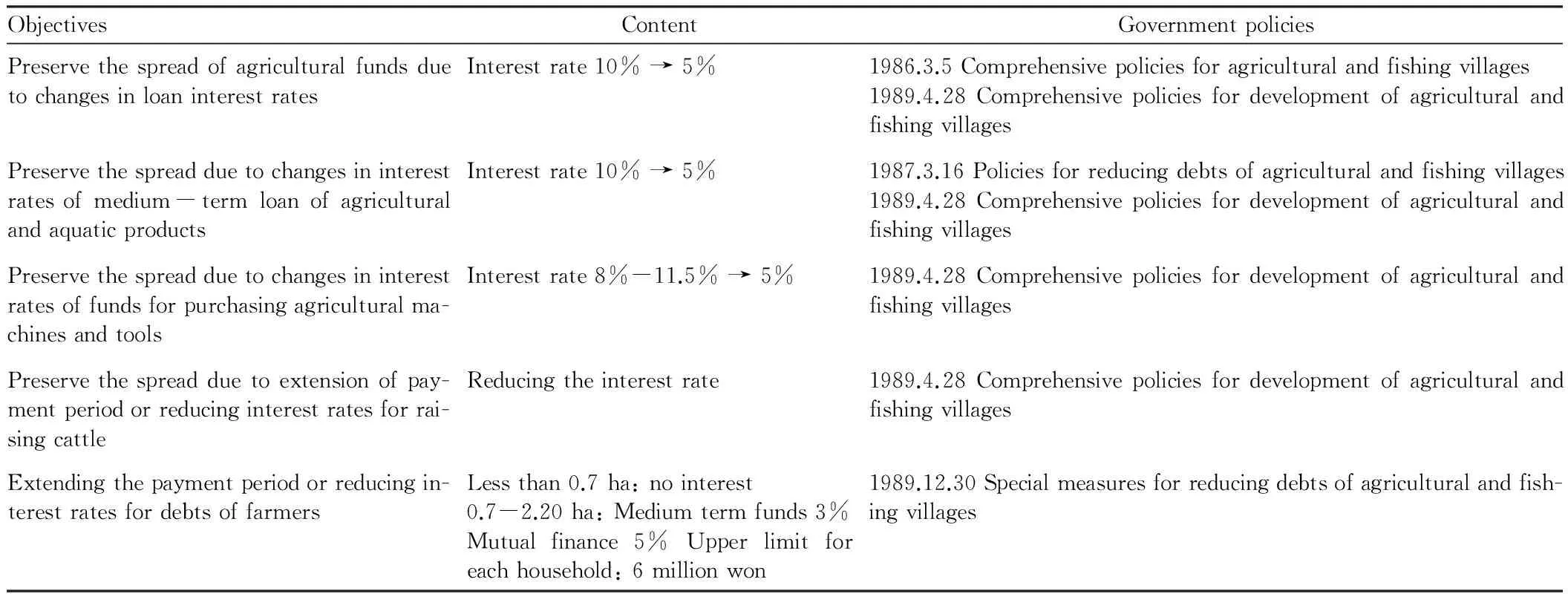
ObjectivesContentGovernmentpoliciesPreservethespreadofagriculturalfundsduetochangesinloaninterestratesInterestrate10%→5%1986.3.5Comprehensivepoliciesforagriculturalandfishingvillages1989.4.28ComprehensivepoliciesfordevelopmentofagriculturalandfishingvillagesPreservethespreadduetochangesininterestratesofmedium-termloanofagriculturalandaquaticproductsInterestrate10%→5%1987.3.16Policiesforreducingdebtsofagriculturalandfishingvillages1989.4.28ComprehensivepoliciesfordevelopmentofagriculturalandfishingvillagesPreservethespreadduetochangesininterestratesoffundsforpurchasingagriculturalma-chinesandtoolsInterestrate8%-11.5%→5%1989.4.28ComprehensivepoliciesfordevelopmentofagriculturalandfishingvillagesPreservethespreadduetoextensionofpay-mentperiodorreducinginterestratesforrai-singcattleReducingtheinterestrate1989.4.28ComprehensivepoliciesfordevelopmentofagriculturalandfishingvillagesExtendingthepaymentperiodorreducingin-terestratesfordebtsoffarmersLessthan0.7ha:nointerest0.7-2.20ha:Mediumtermfunds3%Mutualfinance5%Upperlimitforeachhousehold:6millionwon1989.12.30Specialmeasuresforreducingdebtsofagriculturalandfish-ingvillages
Data source:FiftyYearsHistoryofSouthKoreanAgriculturalandFinancialPolicies, Korean Rural Economic Institute, Book 1, p.812.
4 Agricultural and financial policies of South Korea in the 1990s to the beginning of the 2000s
4.1OverviewSince 1995, South Korea has to face the pressure of all-round opening of agricultural products changing from the past GATT system to the WTO system. In addition to outbreak of the financial crisis in 1997, these led to serious deterioration of the domestic economic and financial environment. After negative growth rate appeared in 1998, through emergency aid of IMF, the situation got stable and improved in the second half of 1999, and South Korea gradually got rid of financial crisis. During the financial crisis, livestock farmers suffered the worst influence of financial crisis.
4.2StructureofgovernmentbudgetIn order to expand the agricultural financial funds, the South Korean government set up accounting for improving structure of agricultural and fishing village in 1992, set up accounting for agricultural special taxes in 1995, and set up farmland management fund in 1990[8]. (i) Accounting for improving structure of agricultural and fishing villages. In view of pressure of market opening and to increase the competitiveness of agricultural and fishery products, the South Korean government strengthened support cultivating agricultural professionals and improving the structural environment of agricultural and fishing villages. (ii) Accounting for agricultural special taxes. In order to ensure the safety of agricultural finance, South Korea imposed import tariffs on agriculture, forestry and fishery in each fiscal year, and the full amount of additional taxes for mixed feed and livestock products would be withdrawn from this account. (iii) Farmland management fund. This fund included farmland management and farmland production accounts. The account for farmland management mainly deals with the farmland sale and purchase, long-term lease, and exchange in the large scale development of fragmental agriculture.
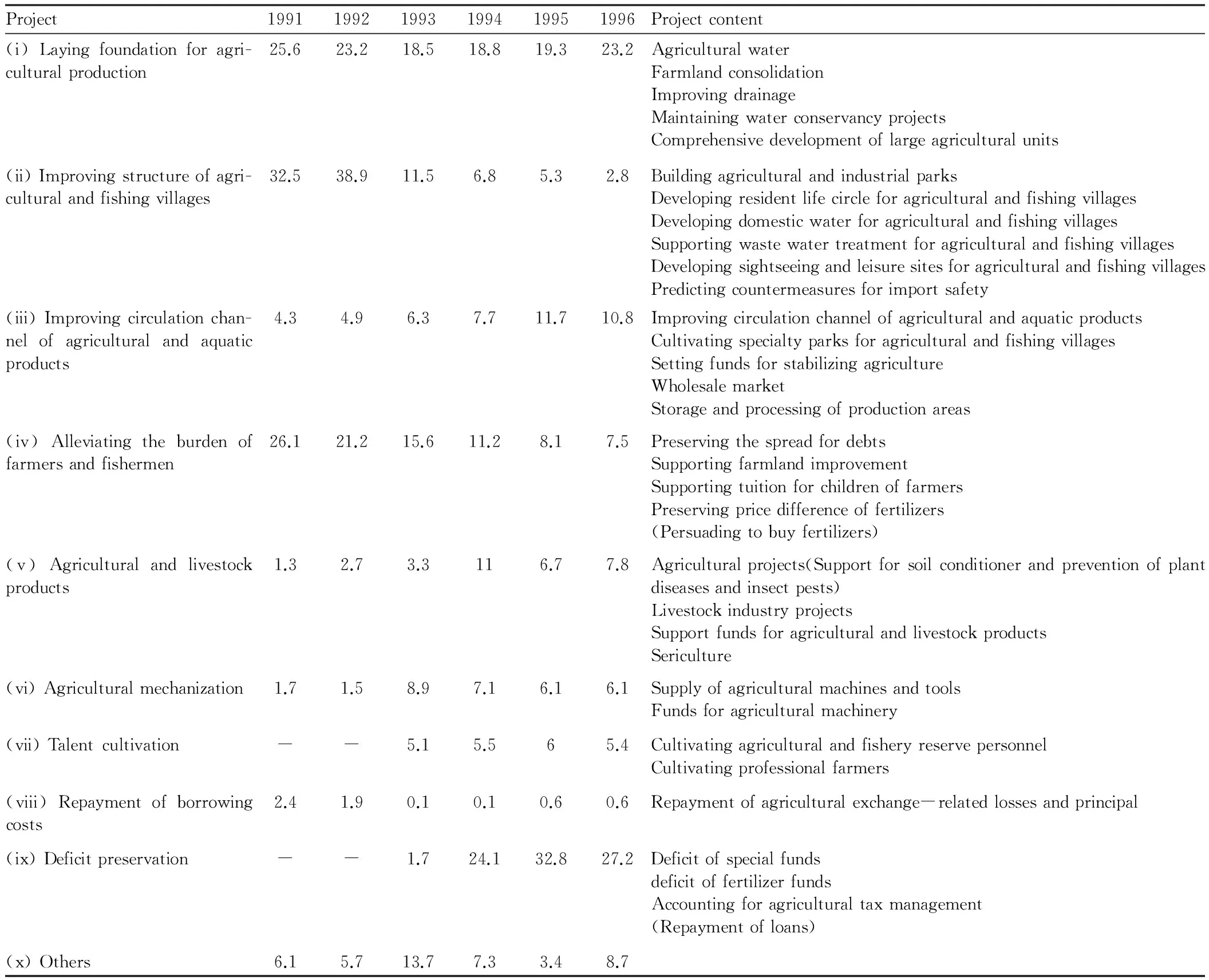
Table 2 Allocation of financial budget for agricultural and forestry sectors in the 1990s Unit: %
Data source:FiftyYearsHistoryofSouthKoreanAgriculturalPolicies, Korean Rural Economic Institute, Book 1, p.832.
4.3KeyagriculturalprojectsIn the 1990s, the division of labor in the agricultural sector was more sectionalized and could be broadly divided into several projects. (i) Laying foundation for agricultural production. This item accounted for the largest portion in financial budget in the 1990s. According to Table 5, it accounted for 25.6% in 1991 and 23.2% in 1996. In 1993, farmland foundation upgrade was included into financial budget; in 1997, it consolidated a total of 738000 ha of farmland and completed 82% of the general plan; In 1997, it completed 80000 ha of drain pipes, accounting for 40% of the general plan. (ii) Improving structure of agricultural and fishing villages. In 1995, it started to solve domestic water and agricultural processing water problems of agricultural and fishing villages. Besides, it started to improve living environment of permanent residents. (iii) Improving circulation channel of agricultural and aquatic products. The financial support for this project increased from 4.3% in 1991 to 10.8% in 1996. (iv) Alleviating the burden of farmers and fishermen. From 1990, South Korea started to provide tuition support for children of farmers. (v) Agricultural and livestock industry projects. Agricultural and livestock industry projects included support for soil conditioner, prevention of pests and diseases, and pesticide safety equipment; livestock industry projects included livestock vaccination, livestock mechanization, seriation of livestock products, and financial support for fragmentary farmers. (vi) Agricultural mechanization. The South Korean government provided funds for purchase of agricultural machines and tools. In 1993-1997, the South Korean government provided subsidies for sales of agricultural machines and tools at half price. (vii) Talent cultivation. Firstly, it provided loan support. To make farmers have qualified successors, South Korea provided 25 million won loan financing for each person in 1997. Secondly, it provided support for cultivating professional farmers. (viii) Repayment of borrowing costs. For loans of development of large agricultural units, agricultural water, and farmland, it provided support for repayment of loan principal. By 1980, major part of the principal had been paid, but the exchange difference still needed to make up for some appropriated budget.
In the early 2000s, the most important mission was to properly establish and improve the agricultural and forestry financial policies within the framework of WTO rules. There were great changes in content and scale of agricultural and forestry financial budget of South Korea, as shown in Table 3. It evolved into the general accounting, accounting for improving structure of agricultural and fishing villages, accounting for finance financing, accounting for state-owned property management, accounting for operating organizations, accounting for grain management, and accounting for agricultural tax management. Since the 1990s, the proportion of farmers engaged in agriculture has been declining, while the new external environment promoted the development of agricultural technology and productivity. In this situation, there appeared many new problems, including the problems of calculating the financial scale to be negotiated within the framework of WTO rules, the problems of sources of financial resources, the problem of how to allocate financial expenditure more reasonably and carefully, and the how to improve the efficiency of the relevant financial funds.
In early 2000, South Korean determined the direction of agricultural financial policies. First, the direction of policies should be determined through the effective use of financial instruments. Secondly, the agricultural financial policies should be coordinated with general financial policies and macroeconomic policies. Thirdly, agricultural productivity and income of farmers should realize parallel development. Fourthly, the government and private investment should be treated differently in how to choose the means of agricultural financial policies. Fifthly, the influence of agricultural financial policies on all levels of farmers should be analyzed. Sixthly, the opening of rice market on the South Korea should be treated properly. Seventhly, it was to improve the efficiency of financial expenditure and advance of agricultural production system. In sum, from the 1970s to the early 2000s, the subsidy of the South Korean government for the agricultural finance showed its own characteristics and conformed to its policies, means, objects and operating systems from the perspective of historical evolution and development.

Table 3 Scale of agricultural and forestry financial budget in 1998-2002 Unit: 108 won
Data source:WTO/DDAAgriculturalNegotiationandAgriculturalandForestryPolicyDirection, Jin Yongze, 2003.
5 Inherent logic of evolution of South Korean agricultural financial policies
Since the new village movement in the 1970s, the proportion of government budget for agriculture, forestry and fishery to the state budget expenditure has been increasing. Through regulation and rectification, it began to gradually restore and increase investment from 1999. Table 4 showed the detailed calculation of the proportion of agricultural and fishery expenditure to the total national budget at each stage. The long-term financial investment of South Korean government in agriculture has played an important role in narrowing the income gap between urban and rural areas (as shown in Fig. 1). However, it is still a thorny to prevent urban and rural incomes from widening and protect the interests of farmers. Because the South Korean government attached great importance to agricultural development, the income gap between urban and rural areas is not very wide, and the income of some farmers was even higher than that of urban residents. How to increase the income of farmers and reduce the burden on farmers is also a long-term issue. It can also be seen from Table 4 that the gap between urban and rural incomes had little change during the mid-1990s, but it was gradually widened in the mid-to-late 1990s and the 2000s. According to research of Jin Jingde and Ren Zhien[5], the main reason for this is that with the increase in the urbanization in Korea, the income level of different regions and different classes started to increase. The financial accounting projects, funds, and other projects of South Korea tend to become more detailed and complex, and its mode of operation becomes gradually computerized, systematic and advanced.
These can be reflected from the evolution and changes in allocation of financial budget of South Korean agricultural department from the 1970s to the 2000s. Increasing financial investment in rural market education and welfare is an effective approach to improve the rural development structure. First, the South Korean government started establishing agricultural and fishing village reserve talent education fund in 1980, to attach importance to rural education investment[9]. This has been taken a long-term development strategy all the time. By the 2000s, in order to further cultivate professional, scientific and technological agricultural talents, South Korean government continued to support agricultural financial policies. Second, from 1990, South Korean government started support tuition for children of poverty-stricken farmers, which provides and solves the substantive economic difficulties for rural poor farmers and fishermen. Third, South Korea continued to support improving the living environment, expanding medical facilities, making investment in education and cultural facilities. South Korean government energetically built agricultural and industrial parks, and wholesale market to provide convenient conditions for alleviating the labor market and increasing income of farmers. South Korean government flexibly used various financial instruments to develop agriculture, such as a variety of agricultural and fishing village development funds, and preferential loan interest rates, and so on.
Table4Proportionofagriculture,forestryandaquaticproductiontototalbudgetexpenditureofSouthKoreanin1970-2000
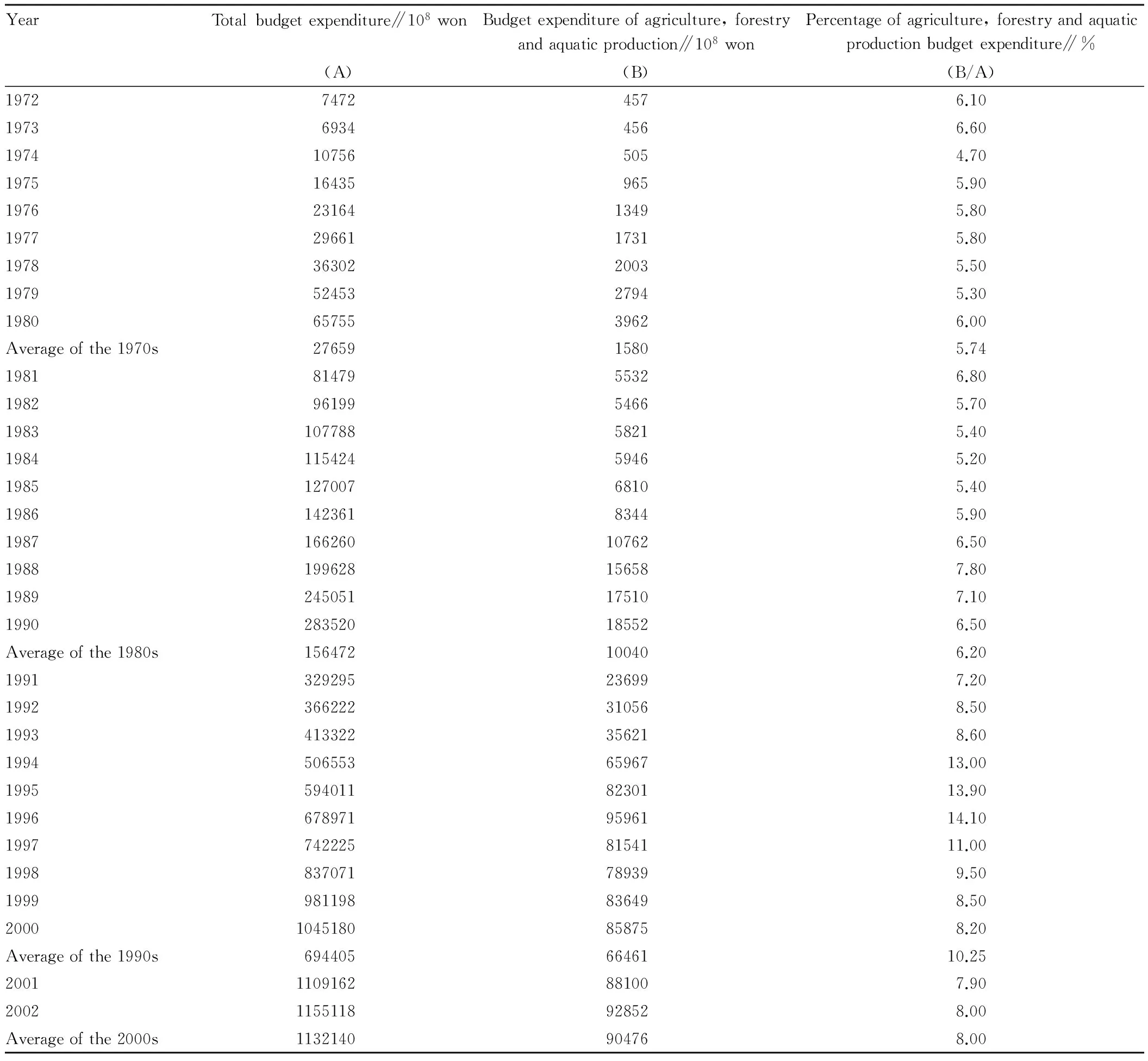
YearTotalbudgetexpenditure∥108wonBudgetexpenditureofagriculture,forestryandaquaticproduction∥108wonPercentageofagriculture,forestryandaquaticproductionbudgetexpenditure∥%(A)(B)(B/A)197274724576.10197369344566.601974107565054.701975164359655.9019762316413495.8019772966117315.8019783630220035.5019795245327945.3019806575539626.00Averageofthe1970s2765915805.7419818147955326.8019829619954665.70198310778858215.40198411542459465.20198512700768105.40198614236183445.901987166260107626.501988199628156587.801989245051175107.101990283520185526.50Averageofthe1980s156472100406.201991329295236997.201992366222310568.501993413322356218.6019945065536596713.0019955940118230113.9019966789719596114.1019977422258154111.001998837071789399.501999981198836498.5020001045180858758.20Averageofthe1990s6944056646110.2520011109162881007.9020021155118928528.00Averageofthe2000s1132140904768.00
Data source:FiftyYearsHistoryofSouthKoreanAgriculturalPolicies, Korean Rural Economic Institute, Book 1, p.846;BudgetSummaryandMainStatisticsofAgricultureandForestrycompiledbyTheMinistryofAgricultureandForestry; statistical table of each year was calculated by us.
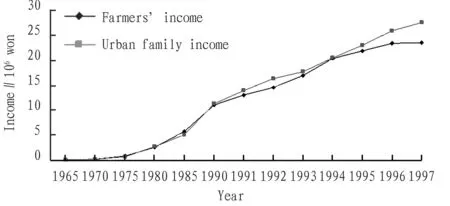
Data source: plotted according to data in Table 5.
Fig.1ComparisonofurbanandruralincomeinSouthKorea
Table5ComparisonofurbanandruralincomeinSouthKorea
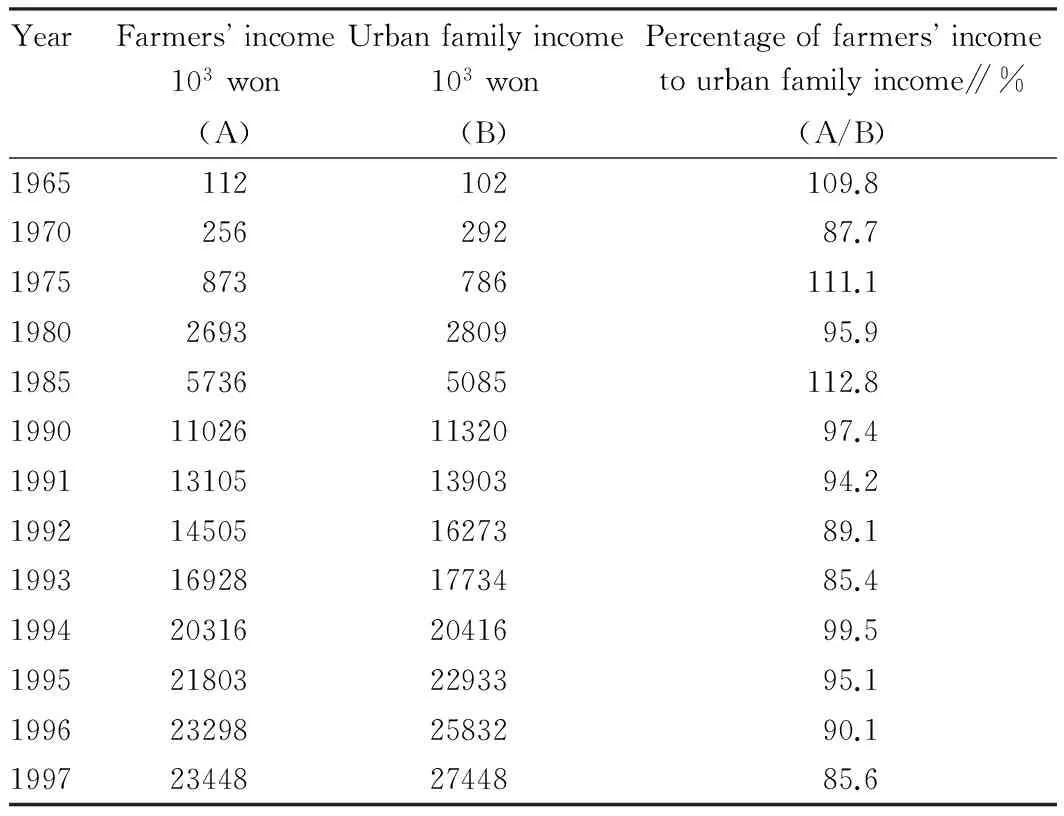
YearFarmersincome103wonUrbanfamilyincome103wonPercentageoffarmersincometourbanfamilyincome∥%(A)(B)(A/B)1965112102109.8197025629287.71975873786111.119802693280995.9198557365085112.81990110261132097.41991131051390394.21992145051627389.11993169281773485.41994203162041699.51995218032293395.11996232982583290.11997234482744885.6
Data source:FiftyYearsHistoryofSouthKoreanAgriculturalPolicies, Korean Rural Economic Institute, Book 1, p.841;MainStatisticsofAgricultureandForestry, The Ministry of Agriculture and Forestry, 1998.
6 Conclusions and discussions
The amount of agricultural financial expenditure is closely closed with the economic development stage. From the experience of South Korea, the new village movement in the 1970s, the 1988 Olympic Games, 1995 WTO system transition period, and the 1997 financial crisis have proved this, which is very similar to current situation of new socialist countryside construction in China. Therefore, no matter the current new socialist countryside construction or the 2008 Beijing Olympic Games, as well as the transition of WTO system, it is required to strengthen the input in agricultural financial policies. As a type of manifestation of public policy, agricultural financial policy is economic in content, but its purpose and effect have exceeded the economic scope. For China, this is particularly prominent. Thus, the Chinese government should give full play to the irreplaceable role of agricultural finance in the building of moderately prosperous society in all respects. (i) Investment in agricultural finance should be continuous, and this should not be neglected. (ii) In the process of rural population transfer, China should pay attention to and solve the problem of farmland abandonment. (iii) It is worthwhile to draw lessons from the successful experience of the market-oriented economy in the state-leading environment. (iv) Narrowing the income gap between urban and rural areas and solving the problem of rural education investment are favorable for providing financial assistance and achieving excellent effect. (v) Actively using targeted financial policy tools. South Korean government supports the rural development through the establishment of a variety of rural funds and preferential interest rate subsidy policy. This is also worthy of learning for China. (vi) The lesson of South Korea’s failure in agricultural financial policy lies in weak time effect of issue of policies. Especially in the rapidly changing external environment, government should size up the current situation. Otherwise, the policy may generate side effects. Due to the limited data, many issues are to be further explored, for example, China and South Korea planned to establish bilateral agricultural financial policies under the premise of free trade agreement (FTA) in 2015.
[1] WANG HJ. Study on the performance of agricultural fiscal policies in China[J]. Business, 2013(15): 156. (in Chinese).
[2] SONG ML, PIAO JJ, JIN GS,etal. The direction improving agriculture and agricultural policies for sustainable agriculture finance[D]. Korean Institute for Rural Economic Research, 2013: 1-227. (in Korean).
[3] LI H. The future orientation of agricultural fiscal expenditure policies[J]. Review of Economic Research, 2012(42): 27, 49. (in Chinese).
[4] PIAO AH. A comparative study on the agricultural supports system between China and South Korean[D]. Ji’nan: Shandong Normal University, 2011. (in Chinese).
[5] JIN JD, REN ZE. Analysis on the physical forms among the regions and stratumand the key reasons[D]. Korean Institute for Rural Economic Research, 2011: 1-64. (in Korean).
[6] MA XC. Repbulic of Korea’s agricultural subsidy policy and its implications[J]. Journal of Agrotechnical Economics, 2010(7): 122-128. (in Chinese).
[7] LIU YH. A comparative study on provincial agricultural fiscal expenditure and farmers’ income in China[D]. Hanyang University, 2010, 34(3): 91-110. (in Korean).
[8] QU TT, ZHANG HO. The experience and reference of financial support for rural development in Korea[J]. Economic Review, 2009(5):112-114. (in Chinese).
[9] JIN YZ. WTO/DDA agriculture negotiation and the agriculture and forestry policies in the future[D]. Korean Institute for Rural Economic Research, 2003(4) . (in Korean).
[10] Chinese Academy of Agricultural Sciences(CAAS)[DB/OL]. www.caas.net.cn. (in Chinese).
[11] China Agricultural Information Network[DB/OL]. www.caein.com. (in Chinese).
[12] Chinese Academy of Social Sciences[DB/OL]. www. cass.cssn.cn. (in Chinese).
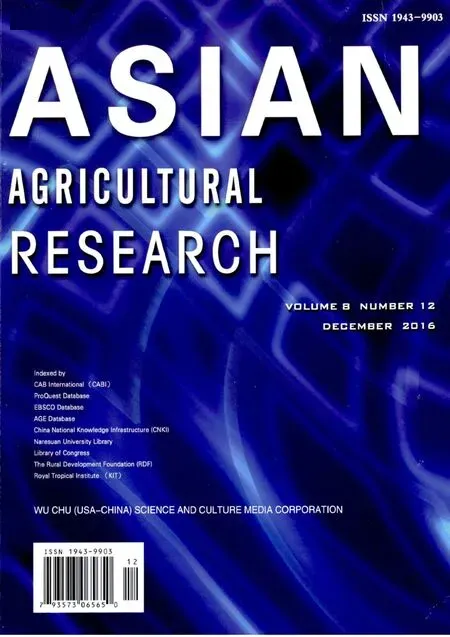 Asian Agricultural Research2016年12期
Asian Agricultural Research2016年12期
- Asian Agricultural Research的其它文章
- Shanghai "Maker" Urban Culture Construction in the Context of Big Cloud Movement
- Realistic Meaning of Agricultural Crisis Theory of Marx and Engels
- Current Situation and Mental Health and Intervention Measures of Left-behind Children
- Analysis on Development of Rural Financial Management Informationization
- Survival Predicament and Recommendations for Second Generation Farmers in Northwest China
- Problems in Development of Rural E-commerce and Logistics and Recommendations
